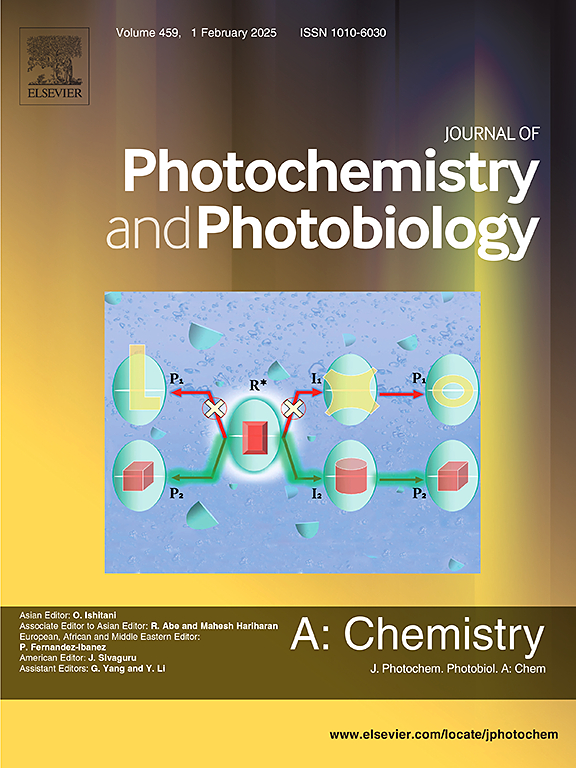CO2 photo-reduction with polyoxometalates-porphyrin based COF: A deep dive into spectroscopy and thermal behavior
IF 4.1
3区 化学
Q2 CHEMISTRY, PHYSICAL
Journal of Photochemistry and Photobiology A-chemistry
Pub Date : 2024-11-20
DOI:10.1016/j.jphotochem.2024.116171
引用次数: 0
Abstract
The reduction of carbon dioxide (CO2) to valuable fuels is crucial for mitigating the climate change and developing the sustainable energy sources. This study explored the use of photo catalyst namely ZnADCOF@MnTP containing metalloporphyrin and χ-Anderson polyoxometalates (POMs) for CO2 reduction. This is clearly demonstrated that ZnADCOF@MnTP exhibited significant changes in its environment after interaction with CO2, as evidenced by shift in spectra of FT-IR (Fourier Transform infrared spectroscopy), UV–visible (Ultra-violet visible spectroscopy), and Raman spectra, along with TGA (Thermogravimetric analysis), and DSC (Differential scanning calorimetric) analysis. These changes indicate the formation of new carbon containing species, and modifications in its oxidation state. ZnADCOF@MnTP showed a remarkable reduction in thermal stability upon interaction with CO2, which is due to its enhanced photocatalytic activity, and also indicated that adsorption, has been occurred. CO2 adsorption and desorption capacities for ZnADCOF@MnTP has also been studied to analyze the adsorption and desorption capacities of the ZnADCOF@MnTP for fresh and regenerated catalyst. The maximum amount of CO2 that has been adsorbed, by ZnADCOF@MnTP is found to be 2.045 (mmol/g) and desorbed capacity is found to be 30 %. GC–MS spectra showed the reduction of CO2 to methanol and formic acid with 0.16 %, and 0.09 % relative concentration which inferred that the ZnADCOF@MnTP is more selective for photoreduction of CO2 to methanol as compared to formic acid.
用聚氧化金属-卟啉基 COF 进行二氧化碳光还原:深入研究光谱学和热行为
将二氧化碳(CO2)还原为有价值的燃料对于减缓气候变化和开发可持续能源至关重要。本研究探讨了利用含有金属卟啉和 χ-Anderson 聚氧金属盐(POMs)的光催化剂 ZnADCOF@MnTP 来还原二氧化碳。傅立叶变换红外光谱(FT-IR)、紫外可见光谱(UV-visible)和拉曼光谱以及热重分析(TGA)和差示扫描量热分析(DSC)的光谱变化都清楚地证明了这一点。这些变化表明形成了新的含碳物种并改变了其氧化态。ZnADCOF@MnTP 与二氧化碳作用后,热稳定性显著降低,这是因为其光催化活性增强了,同时也表明吸附作用已经发生。此外,还对 ZnADCOF@MnTP 的二氧化碳吸附和解吸能力进行了研究,以分析新催化剂和再生催化剂对 ZnADCOF@MnTP 的吸附和解吸能力。发现 ZnADCOF@MnTP 吸附的最大二氧化碳量为 2.045(毫摩尔/克),脱附能力为 30%。气相色谱-质谱(GC-MS)光谱显示,相对浓度分别为 0.16 % 和 0.09 % 的二氧化碳被还原成甲醇和甲酸,由此推断,与甲酸相比,ZnADCOF@MnTP 在将二氧化碳光还原成甲醇方面具有更高的选择性。
本文章由计算机程序翻译,如有差异,请以英文原文为准。
求助全文
约1分钟内获得全文
求助全文
来源期刊
CiteScore
7.90
自引率
7.00%
发文量
580
审稿时长
48 days
期刊介绍:
JPPA publishes the results of fundamental studies on all aspects of chemical phenomena induced by interactions between light and molecules/matter of all kinds.
All systems capable of being described at the molecular or integrated multimolecular level are appropriate for the journal. This includes all molecular chemical species as well as biomolecular, supramolecular, polymer and other macromolecular systems, as well as solid state photochemistry. In addition, the journal publishes studies of semiconductor and other photoactive organic and inorganic materials, photocatalysis (organic, inorganic, supramolecular and superconductor).
The scope includes condensed and gas phase photochemistry, as well as synchrotron radiation chemistry. A broad range of processes and techniques in photochemistry are covered such as light induced energy, electron and proton transfer; nonlinear photochemical behavior; mechanistic investigation of photochemical reactions and identification of the products of photochemical reactions; quantum yield determinations and measurements of rate constants for primary and secondary photochemical processes; steady-state and time-resolved emission, ultrafast spectroscopic methods, single molecule spectroscopy, time resolved X-ray diffraction, luminescence microscopy, and scattering spectroscopy applied to photochemistry. Papers in emerging and applied areas such as luminescent sensors, electroluminescence, solar energy conversion, atmospheric photochemistry, environmental remediation, and related photocatalytic chemistry are also welcome.

 求助内容:
求助内容: 应助结果提醒方式:
应助结果提醒方式:


